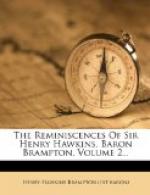The key was not in the lock, neither had it fallen out, or it would have been found somewhere near. It had evidently been taken out and secreted, because it was found at the bottom of a dustbin a long way off from the staircase and in the room occupied by the prisoner.
There was one additional fact at this part of the view which I must mention. A bullet was picked up near the door. It had struck the opposite wall, and then glanced off and hit the other wall close to the door.
The bullet had been fired from the landing above; this was indicated by the direction as it glanced along the wall, and, further, by the mark it had left of its line of flight from the landing above, for it had struck against the low ceiling of that spot as though the person firing had fired in a hurry and had not taken sufficient aim to avoid it. It might be taken, therefore, that the person firing was not used to firearms, or he would not have hit what might be called the ceiling.
The bullet was produced by the chief constable.
On reaching the second landing, the mark of the bullet in the lintel showed clearly that it had been fired in the direction of some object below—some one, probably, descending the stairs.
On turning into the factory on this floor, which was quite empty, I saw on the wall near the doorway the mark of another bullet which had rested near and was found by the police. It was a bad aim, and showed, therefore, that the person who fired it was unused to firearms.
We went to the next room, into which we ascended by six steps; it was clear that it was from the head of these stairs that the course of the bullet was directed; its elevated position and the angle of incidence showed this. But as neither of these bullets had struck the deceased, for there was no mark of any kind to prove it, there was another bullet to be accounted for, and as the prisoner said that the pistol went off by accident, two or three matters had to be considered. Where was the spot where the accident occurred? and was aim actually taken?
The bullet had entered the hinder part of the neck, had taken a downward direction, and lodged in the spine. It did not, therefore, go off while he was explaining the pistol to her, otherwise it would have struck her at any other place than where it did.
Moreover, she had run in a state of intense fright the moment she was wounded—had commenced to run before, in fact, having escaped from the clutches of her murderer, for the skirt of her dress was torn from the gathers. It was proved that the prisoner had bought the pistol on the Saturday night, that he was unused to firearms, for he had to ask the man who sold it to explain the mode of using it. He was heard practising with it on Sunday, and when the accident occurred it was proved that the interval between the first and second shots exactly accounted for the space which intervened between the respective spots where the firing must have taken place.




